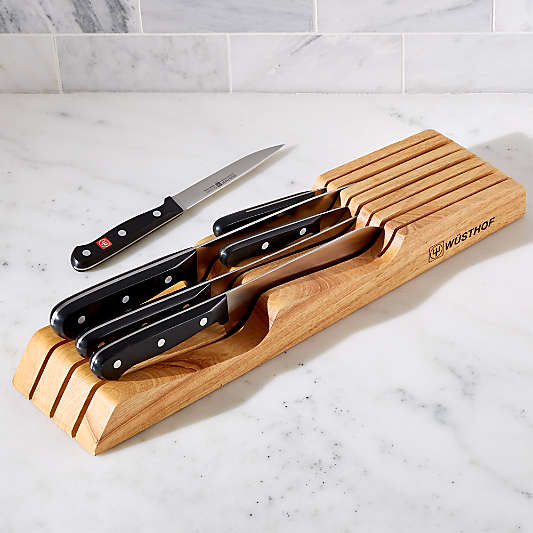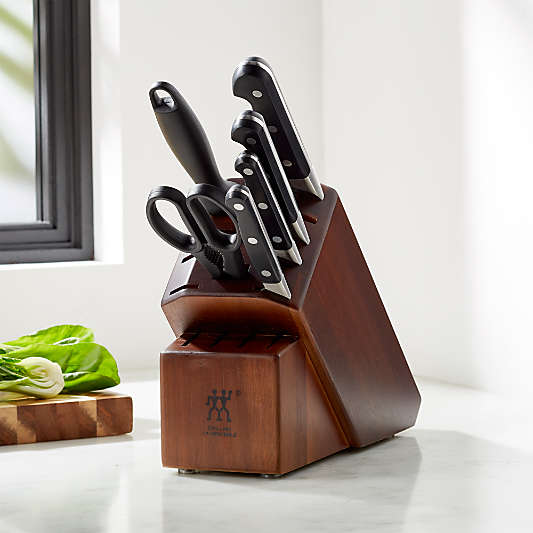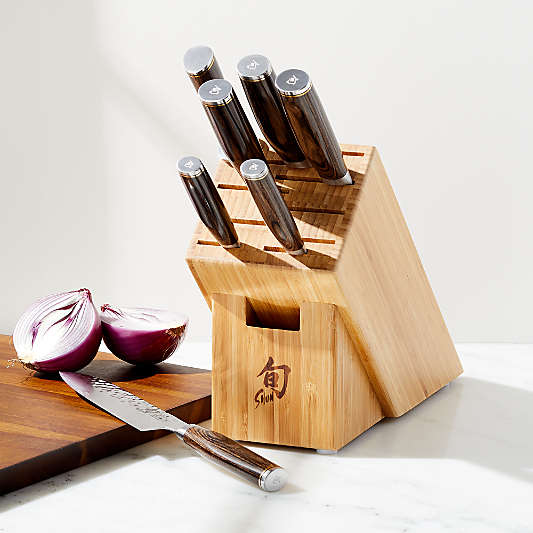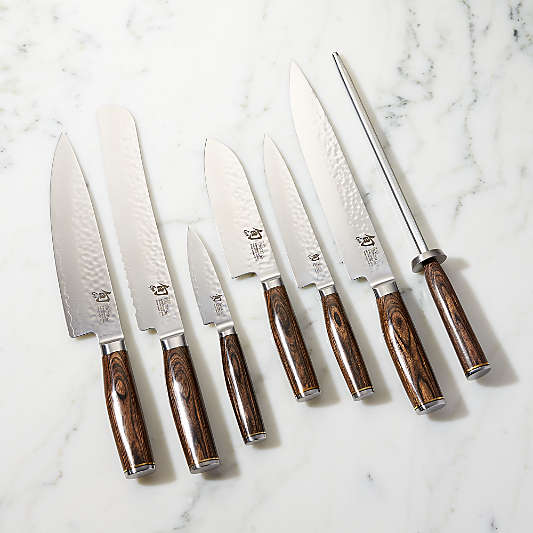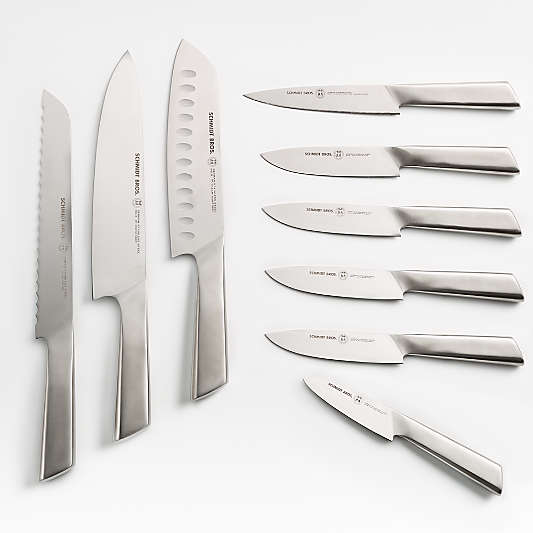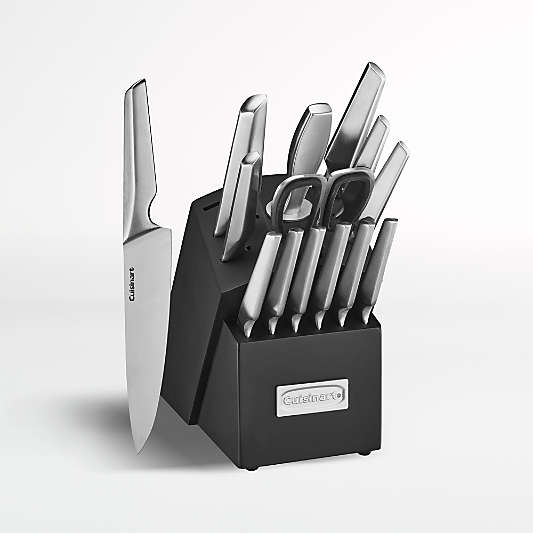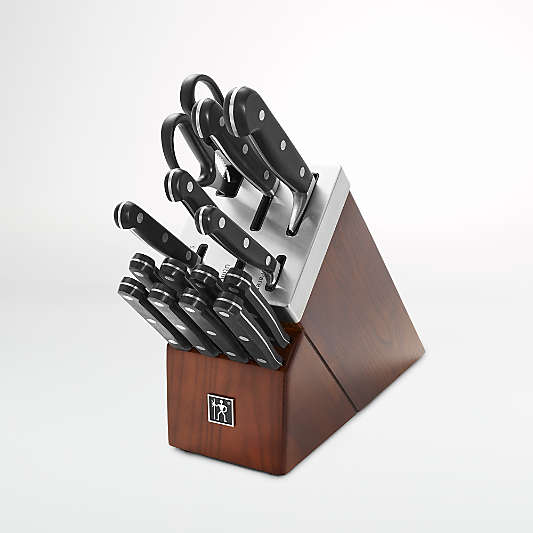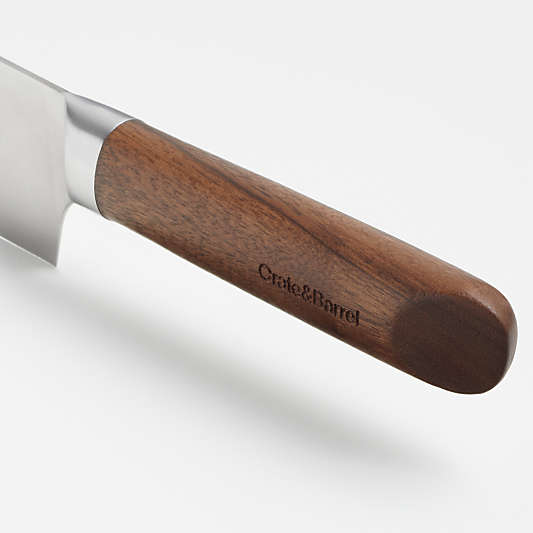6 min read

The first set of knives you buy should be your last. But what’s the best knife? It’s the one that immediately feels like it was made for your hand. It’s also the one that was designed for what you’re slicing, dicing, mincing and more. Read on to learn about what you should consider when buying a kitchen knife or set.

types of knives and their uses
For every task, there is a knife. The basic type of knives most cooks need include Chef’s, Paring, Slicer, Bread and Fruit/Vegetable. Many of these are available in different sizes for different jobs. Read on to learn more.
Boning Knives
The narrow blade and sharp point of a boning knife allows for easier access when maneuvering around bones in raw or cooked meat, poultry and fish. You can use a boning knife to break down a chicken; the long thin blade easily slices the meat and the point neatly cuts through the joints between the bonesIt can also be a great tool for removing the skin from fish fillets.
Bread Knives
Long and serrated, bread knives neatly slice through crusts and pastries without compressing or compromising softer interiors. Can a bread knife be used for things other than bread? Yes! The serrated blade on a bread knife is the perfect tool for leveling cakes and slicing through produce with thicker skins like tomatoes or melons.
Chef's Knives
This is the chameleon of knives. With its classic wide blade, a chef’s knife is efficient at repetitive slicing, dicing, mincing and chopping fruits, veggies and meats. Chef’s knives come in a variety of lengths, with 8-inch being the most common. The blade has a high profile that keeps knuckles from colliding with the cutting board, and its gently curved edge that allows for a rocking motion that chefs love. According to trained chef and in-house culinary expert at Crate & Barrel Alia Dalal, “One of the best things about a chef’s knife is that you can use a continuous rocking motion to slice a lot of produce without having to take the tip of your knife off of the cutting board. If I had just one knife in my kitchen it would be a chef’s knife because of its versatility in tackling just about any task.”
Cleavers
A cleaver isn’t just for the butcher shop. If you prepare meat and poultry, a cleaver is useful because it can easily chop through bones and cartilage, protecting your thinner knives from chipping or dulling. You can also use a cleaver on tough or dense produce like butternut squash or pineapple.
Santoku Knives
The Santoku, or Japanese Chef's Knife, translates to "three great things," which are slicing, dicing and mincing. A Santoku is a large multipurpose knife similar to a chef’s knife but it has less of a curve on the edge, and it has a hooked or downturned tip. It can be used almost interchangeably with a chef’s knife, although it’s a slightly better choice for a slicing style that uses straight downward strokes versus a continuous rocking motion on the cutting board.
Paring Knives
For the detail-oriented. The paring knife (or utility knife) has a small blade that provides close control for peeling or cutting delicate fruits and veggies. Use a paring knife for finer tasks, often performed in your hand, like hulling a strawberry, deveining shrimp, or coring an apple or cauliflower.
Slicing Knives
A slicing knife has a long, thin, sharp blade made for thinly slicing roasts like beef tenderloin, turkey or ham in clean, long strokes. Similar to a carving knife, slicing knives are a better choice for this task than a chef’s knife. Other knives are often too short and uneven for a clean slicing job (but can do in a pinch).
Steak Knives
Steak knives have a blade with a serrated or smooth edge for more control when slicing meat. Their curved handles rest comfortably in-hand and they’re sized to look right next to other cutlery in a place setting. Despite the name, these knives aren’t just for steak. You can set the table with these to enjoy other hearty dishes like Thanksgiving turkey, lamb chops or roast chicken.
Vegetable Knives
There are a variety of specialty knives that are optimized to prepare different vegetables and fruits. In this category, you’ll find tomato knives, peeling and trimming knives, watermelon knives and citrus knives. Traditional Japanese knives like a nakiri and a usuba are other great choices since their rectangular shape allows efficient and precise chopping of a variety of produce.

parts of a kitchen knife
Blade
The sharp, metal part of the knife used for cutting, slicing and chopping.
Edge
The sharpened edge of the blade that does the cutting.
Spine
The thick, blunt part of the blade opposite the edge.
Full Tang
The part of the blade that extends into the handle and provides balance and stability to the knife. Typically less expensive knives do not feature a full tang, but instead only a partial tang which is often less durable.
Bolster
The thick junction between the blade and handle that provides balance and stability.
Handle
The part of the knife that is gripped while cutting. Handles can be made from a variety of materials like wood, plastic, or metal.
Tip
The pointed end of the blade used for making precise cuts and piercing.
kitchen knife craftsmanship
The craftsmanship of a kitchen knife is an important factor in its performance and longevity. There are two primary methods for creating kitchen knife blades: forging and stamping. Take a closer look at the methods below.
Forged Kitchen Knives
Made from a solid piece of steel, forged knives are heated, tempered, sharpened and often finished by hand. A forged knife typically has a bolster, which is a raised area between the handle and blade that enhances strength, stability and comfort in your hand.
Stamped Kitchen Knives
A stamped knife is cut from a continuous sheet of steel. Its blade is machine tempered, sharpened and finished, then fit into the handle and attached with rivets. Stamped cutlery is typically lighter than forged.
kitchen knife blade materials
There are several common materials used for kitchen knife blades, each with its own unique properties and advantages. When choosing a knife, consider your personal preferences and intended use, as well as the maintenance and care required for each blade material. Read on to learn more.
Stainless Steel
A popular choice, stainless steel knives are highly resistant to rust and staining and are generally pretty easy to maintain and clean. However, stainless steel is not as hard as some materials and may require more frequent sharpening.
Carbon Steel
Knife blades made of carbon steel tend to be harder than stainless steel knives, which means they can hold their edge better and require less sharpening. Carbon steel can, however, require more maintenance to keep it in good condition.
Ceramic
Ceramic blades are extremely hard and can hold their edge for a long time, requiring less sharpening than other materials. They are also resistant to rust. However, ceramic blades can be brittle and prone to chipping or breaking if they are dropped or mishandled.

kitchen knife care
Proper care and maintenance of kitchen knives is essential for keeping them in good condition and ensuring they perform at their best. Here are some tips for taking care of your kitchen knives.
Cleaning Kitchen Knives
Rinse knives immediately after use. Hand wash with warm, soapy water with the blade pointed away. Dry with a soft cloth.
Storing Kitchen Knives
Keep your knives in a dry place where their blades won't scuff other kitchen tools (which could also dull the blades over time). Choose a block, magnetic wall bar, dock or blade guard. Store knives together and arranged in a way that allows you to easily access the knife you need.
Sharpening Kitchen Knives
A sharp knife is one of the best tools a cook can have on hand. Always consult the manufacturer instructions for sharpening your particular knife since different materials and styles of knives require different sharpening. But in general, some options for keeping your knives cutting cleanly are a honing steel or an electric sharpener. A honing steel will realign the knife's edge to the center. An electric sharpener will sharpen the blade evenly, then polish the surface to a fine finish.

deciding how many kitchen knives to buy
Individual Knives
Looking for just one knife? Completing your starter set? Most knives are available individually so you can customize your collection or double up on knives you use most often.
Knife Block Sets
Freestanding knife block sets offer sleek design and convenient countertop access. Blades stay protected and sharp, and because each knife has a designated spot, you’ll always know where to reach. Choose a starter set, which offers the “building blocks” of a cutlery collection, or opt for a more complete range of knives, from a 12-piece set to a 17-piece and more.
Knife Sets (Without A Block)
Many knife sets come without a block. Take steak knives–, for example. We recommend getting a set of 8-12 steak knives for dinner guests. Store them away from other knives and kitchen tools to keep the blades sharp and scratch-free. We suggest utilizing a storage box—it makes a beautiful presentation right on the table. You can also get knife sets that are pairings of two or more popular knives from one brand. Often these sets are available at a discounted price compared to buying each knife separately, so they are a great option if you need more than one knife. If you love the idea of a knife block but don’t have the countertop space, try an in-drawer knife set. These sets give you the organizational and knife-protecting benefits of a block, all in a space-efficient storage unit that fits in a kitchen drawer.
Shop All Knives












